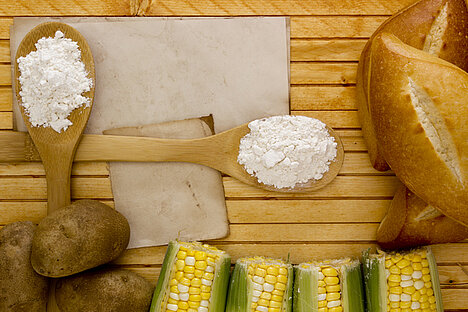Starch

The advantages of starch in dog food
Starch has several advantages for the production and quality of dog food. On the one hand, starch is relatively cheap and can be used as a filler to increase the energy content of the food. Secondly, starch is necessary to press dry food into the form of kibble, as it acts as a binding agent. Starch can also improve the shelf life and taste properties of the food.
For adult dogs, starch is normally easily digestible if it has been broken down by appropriate heating1. Starch can therefore be a quick source of energy for dogs with high energy requirements, such as sporting dogs or pregnant bitches.
The disadvantages of starch in dog food
However, starch also has some disadvantages for the health and well-being of dogs. On the one hand, starch can lead to overweight and obesity if it is fed in excessive quantities. Starch provides a lot of calories, which the dog cannot always consume. Overweight and obesity can in turn lead to various diseases, such as diabetes, joint problems or cardiovascular disorders.
On the other hand, starch can lead to digestive problems or allergies if the dog does not tolerate it well. Puppies, for example, have different enzymes than adult dogs and are less able to digest starch. For this reason, the starch content in a puppy ration should be kept somewhat lower. Some dogs are also allergic to certain sources of starch, such as wheat or maize. In this case, you should switch to hypoallergenic or grain-free food.
How much starch is best for your dog?
The optimal amount of starch in dog food depends on various factors, such as your dog's age, breed, activity level and state of health. There is no general recommendation on how much starch a dog needs per day. However, you should make sure that the food does not contain too much starch, as this can lead to the problems mentioned above.
One way to check the starch content in the food is to read the ingredients list. The ingredients are usually sorted by weight in descending order, i.e. the ingredient with the highest percentage is at the top. So if you find a lot of starchy ingredients such as cereals, potatoes or bananas in the first positions, you can assume that the food has a high starch content. You can also look at the carbohydrate content on the packaging, which is usually given as a percentage. The higher the carbohydrate content, the higher the starch content.
Another way to reduce the starch content in food is to switch to dog food with a high meat content. Meat is the natural food source for dogs and contains hardly any carbohydrates. Dog food with a high meat content consists of at least 70 percent animal proteins and therefore has a low starch content. You can also cook for your dog yourself or feed him raw meat (barf) if you want to control his starch intake precisely.
Starch is a carbohydrate that is found in many plant-based foods and can be a source of energy for dogs. However, starch also has some disadvantages, such as obesity, digestive problems or allergies. Therefore, the starch content in dog food should not be too high and attention should be paid to your dog's needs and tolerance. Dog food with a high meat content or home-cooked or raw food can be good alternatives to starchy food.
If you notice any signs of hypersensitivity or poisoning in your dog, you should see your vet immediately. We are not a substitute for a vet, but we try to be as accurate as possible. Every dog reacts differently and we recommend you get a second opinion or consult your vet if in doubt.
Stay healthy and take good care of your four-legged friend!😊